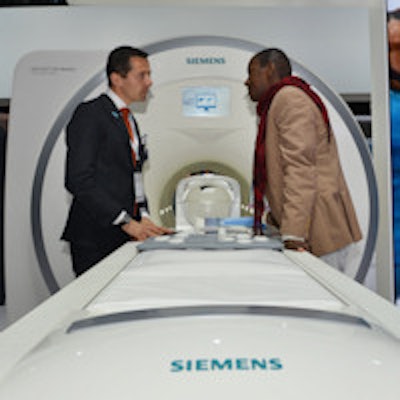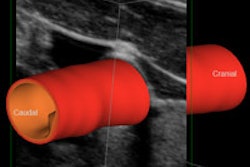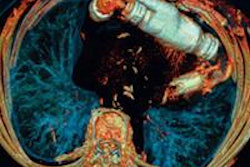
CHICAGO - Siemens Healthcare is promoting a range of new technologies in its booth at RSNA 2014, including a 1.5-tesla MRI scanner, a single-source CT scanner optimized for spectral imaging, and ultrasound and interventional x-ray enhancements.
MRI
Siemens is showcasing its work-in-progress Magnetom Amira 1.5-tesla MRI scanner. The company is touting the scanner's 60-cm bore and its new energy-efficient Eco-Power technology to reduce operating costs, especially when the scanner is in standby mode.
Magnetom Amira is also expected to feature zero helium boil-off technology to prevent the evaporation of helium, which can be a precious commodity. In addition, Quiet Suite technology is designed to minimize noise during an MRI exam for both the patient and staff, while syngo MR E11 software provides the most recent tools for diagnosis.
 Siemens' work-in-progress Magnetom Amira MRI system.
Siemens' work-in-progress Magnetom Amira MRI system.Siemens plans to target radiology practices, small and medium-sized hospitals, and larger facilities for Magnetom Amira to complement existing MRI scanners. The company anticipates an early 2016 release for the system.
Siemens also unveiled its new SEEit technology, which is designed for performing noninvasive prostate MRI exams without an endorectal coil. Pending 501(k) clearance from the U.S. Food and Drug Administration (FDA), SEEit will be available on the Magnetom Aera 1.5-tesla and Magnetom Skyra 3-tesla MRI systems.
SEEit features Siemens' direct radiofrequency (RF) and high-density total imaging matrix (Tim) 4G coil technology, along with its Resolve readout segmentation.
With the new syngo MR E11 software, SEEit allows users to perform a routine multiparametric prostate exam (T2-weighted and Resolve imaging) in approximately 10 minutes with the company's Body 60 channel coil (also pending FDA clearance).
The syngo.via Prostate feature for reading and reporting data provides standardized communication according to PI-RADS, a structured reporting system for prostate MRI.
CT
The big news in the CT section of Siemens' booth is the company's launch of a new version of its Somatom Definition Edge single-source CT scanner that is designed to provide routine dual-energy imaging to a wider range of imaging facilities.
Being shown as a work-in-progress, Edge features new x-ray tube technology that Siemens believes will make dual-energy imaging accessible at the lower price points possible with a single-source scanner.
 Siemens is launching a new version of its Definition Edge single-source CT scanner.
Siemens is launching a new version of its Definition Edge single-source CT scanner.Siemens developed a new technology designed to improve single-source dual-energy imaging. Called TwinBeam Dual Energy, the technique enables the company's Straton tube to split the x-ray beam into two parts: one can be hardened to create a beam that has a higher energy level, while the second part of the beam has a lower energy level.
Clinical applications for dual-energy imaging include tumor analysis and lesion characterization, such as in abdominal scans for liver lesions. It's also useful for emergency imaging, such as evaluating pulmonary embolism, or in vascular scans by removing bone to provide a clearer picture.
In addition to dual-energy imaging, Siemens had added two other technologies to Definition Edge: a new version of its iterative reconstruction technology and a metal artifact reduction algorithm.
For iterative reconstruction, Siemens has adapted for Edge its high-end advanced modeled iterative reconstruction (ADMIRE) algorithm, previously found only on the Force scanner. With respect to metal artifacts, the company has developed iterative metal artifact reduction (IMAR), which uses an iterative approach of looping back to raw data to compensate for metal artifacts.
Siemens is in the process of applying for 510(k) clearance for the new version of Definition Edge, and the company hopes to begin shipping the system outside the U.S. in the first quarter of 2015.
On its flagship Somatom Force dual-source scanner, Siemens is discussing the use of ADMIRE in conjunction with another iterative reconstruction algorithm, sinogram-affirmed iterative reconstruction (SAFIRE), to achieve radiation dose reduction of up to 60%.
Siemens is also talking up syngo.CT Liver Analysis, a software application recently cleared by the FDA that delivers preprocessed segmentation results and workflow guidance for analysis of vascular supply areas, reducing steps required in oncologic surgery. The application provides information on tumor size and location and can help physicians assess the amount of liver tissue that has been resected, enabling them to better understand vascularization of affected liver segments.
For the Somatom Definition Flash scanner, Siemens is migrating technologies such as ADMIRE first pioneered on its high-end Force system with a new software update that will ship in the first quarter of 2015, once it receives FDA clearance.
X-ray and interventional
In interventional x-ray, Siemens is showing as a work-in-progress the Pure platform for its Artis Zee, Artis Q, and Artis Q.zen family of angiography systems. Pure includes a package of enhancements such as a 3D Wizard feature for 3D acquisitions; the feature allows users to click on the type of image they would like and bring up a set of predetermined exam parameters, such as amount and injection rate of contrast.
Meanwhile, a QuickZoom feature enables users to click on a point of interest in syngo DynaCT images of aneurysms to lock on the center of the image while rotating the 3D dataset or adjusting zoom factors with a joystick motion. Also, a syngo 2D/3D Fusion feature provides fusion of preprocedure volume CT, MRI, or PET images using just two fluoro images for live guidance.
 The Mobilett Mira MAX mobile x-ray system.
The Mobilett Mira MAX mobile x-ray system.Siemens said that 510(k) FDA clearance is pending for the Pure upgrade, and shipments are expected to begin in the second quarter of 2015.
Other new interventional tools include syngo Dyna4D software, which enables time-resolved 3D imaging in angiography, allowing 3D visualization of blood-vessel volume as well as blood flow. There is also syngo DynaCT SMART, an algorithm that allows clinicians to remove metal artifacts from medical images, potentially enabling the detection of complications such as hemorrhaging that occur near metallic objects within the patient's body.
In mobile x-ray, Mobilett Mira MAX is a new version of the company's mobile x-ray system that uses the firm's Multiple Advances in X-ray (MAX) wireless digital radiography (DR) detectors, introduced in 2013.
Mobilett Mira MAX is available with two wi-D detector options: One is a 14 x 17-inch detector for routine work, and the second is a 10 x 12-inch detector for specific applications such as hand and wrist imaging. The MAX detectors can also be shared between other systems in the radiography line.
The system is also outfitted with a special tube arm that provides almost unrestricted visibility while the system is being moved, and the arm can be rotated 180°, according to Siemens. The unit can be locked down using a PIN code rather than a key, protecting patient data from being accessed if the technologist has to leave the system unattended.
The new MAX-based mobile system is expected to start shipping at the start of 2015.
Ultrasound
In ultrasound, Siemens is promoting Acuson X600, a new midrange offering in company's X-class of scanners. X600 uses technologies migrating from Siemens' premium X700 system.
For example, real-time spatial compounding and dynamic tissue contrast enhancement (TCE) are designed to reduce image artifacts and improve border detection, while productivity applications simplify exam workflow and reduce the number of keystrokes required to produce images.
 Siemens' Acuson X700 ultrasound scanner.
Siemens' Acuson X700 ultrasound scanner.Also, X600 includes three new volume transducers for better 3D/4D image quality, especially in ob/gyn studies. The scanner began shipping in October.
The Acuson X700 shared-service scanner is getting a new version 2.0 release of software, including the company's SieTouch elasticity imaging protocol for noninvasive analysis of relative tissue stiffness. Other enhancements include automated follicle measurements, a new high-resolution linear transducer, and better image quality for breast and small-parts imaging. Release 2.0 is currently shipping.
For the Freestyle handheld wireless scanner, Siemens is discussing new enhancements in a version 3.5 release that began shipping in November. These include a better user interface, a bigger image display, and easier access to imaging presets.
A needle visualization mode has been added for image-guided needle biopsies, as well as a new application that Siemens developed in collaboration with Microsoft that allows reference images from Freestyle to be sent to an external device such as a tablet. Users can also input patient information into the tablet to send to Freestyle.
Women's imaging
In the women's imaging section of its booth, Siemens is talking up Mammomat Inspiration Prime, the company's flagship full-field digital mammography system. Key features on Prime include an algorithm for progressive image reconstruction that replaces the scatter grid found on conventional mammography systems, lowering radiation dose by up to 30% compared with the previous Siemens model.
For better patient comfort, an Opcomp function applies compression only as long as the patient's breast is soft and pliable, stopping at the point of optimal compression, while the company's MoonLight LED panel allows breast imaging facilities to create a more relaxing environment for patients.
Molecular imaging
Siemens' Symbia Evo Excel makes its debut to RSNA 2014 after the company launched the SPECT scanner in October at the European Association of Nuclear Medicine (EANM) congress.
Siemens is touting Symbia Evo Excel's small footprint, which can fit a room approximately 12 x 15 ft. The scanner also offers a larger bore of 102 cm to image obese or critically ill patients for a variety of clinical applications.
Also being highlighted is Siemens' Biograph mCT Flow PET/CT system, which features FlowMotion to keep a patient moving smoothly through the system's gantry while continuously acquiring images from the PET scan.
Biograph mCT Flow with FlowMotion enables clinicians to focus on individual organs of interest during a whole-body scan, which allows for better disease characterization in therapy monitoring and lower radiation dose for patients. Biograph mCT Flow also features a 78-cm bore and five-minute scan time.
Siemens is also showing its Symbia Intevo xSPECT system, which integrates and reconstructs SPECT and CT images with high-definition CT frame of reference for better clinical detail.
Healthcare IT
Siemens has introduced its soon-to-come cloud-based network known as Teamplay, which is designed to connect radiologists, physicians, and other healthcare providers within a hospital or healthcare system and allow them to share information, such as cases and benchmarks, with colleagues at other institutions.
Among the capabilities planned for Teamplay is the ability to evaluate functions such as scanner capacity utilization, examination times, and radiation doses, and compare the results with in-house and outside performance. Teamplay can run on tablets, laptops, and desktop PCs, subject to authorization and other security measures.
Siemens plans to make Teamplay available in 2015.
The company is also highlighting the latest version of syngo.via 3D and advanced visualization software designed to improve oncologic treatment decisions, planning, and assessment. Siemens is also featuring its latest edition of syngo.plaza PACS and software that combines 2D and 3D reading.
Syngo.plaza now offers a wider range of applications and tools to improve workflow, including Smart Data Conversion for transitioning existing PACS.



















